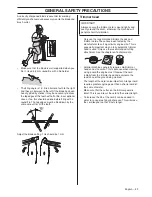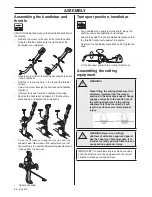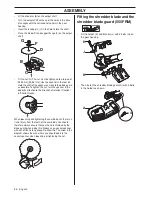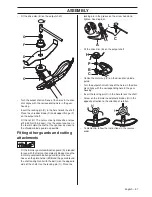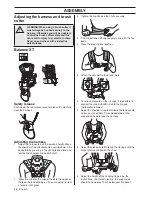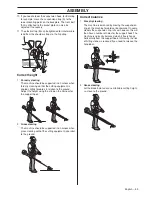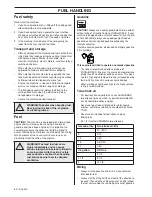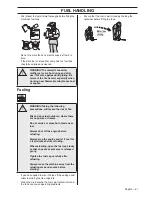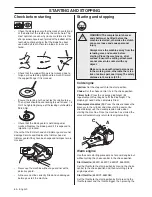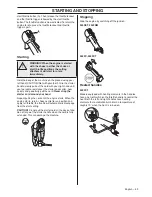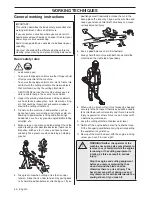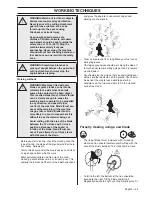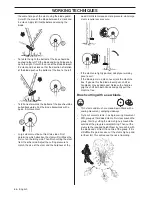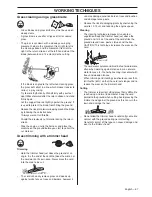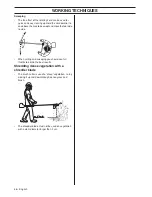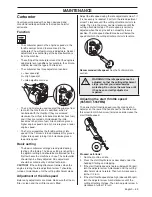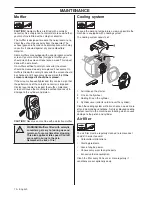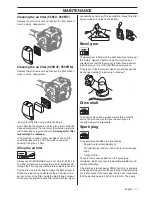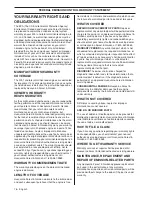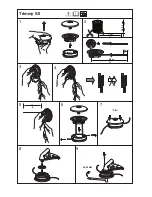
WORKING TECHNIQUES
English
–
65
Working methods
•
Before you start clearing, check the clearing area, the
type of terrain, the slope of the ground, whether there
are stones, hollows etc.
•
Start at whichever end of the area is easiest, and clear
an open space from which to work.
•
Work systematically to and fro across the area,
clearing a width of around 4-5 m on each pass. This
exploits the full reach of the machine in both directions
and gives the operator a convenient and varied
working area to work in.
•
Clear a strip around 75 m long. Move your fuel can as
work progresses.
•
On sloping ground you should work along the slope. It
is much easier to work along a slope than it is to work
up and down it.
•
You should plan the strip so that you avoid going over
ditches or other obstacles on the ground. You should
also orient the strip to take advantage of wind
conditions, so that cleared stems fall in the cleared
area of the stand.
Forestry clearing using a saw blade
•
The risk of blade thrust increases with increasing
stem size. You should therefore avoid cutting with the
area of the blade between 12 o’clock and 3 o’clock.
•
To fell to the left, the bottom of the tree should be
pushed to the right. Tilt the blade and bring it
diagonally down to the right, exerting firm pressure. At
!
WARNING! Watch out for thrown objects.
Always wear approved eye protection.
Never lean over the cutting attachment
guard. Stones, rubbish, etc. can be
thrown up into the eyes causing
blindness or serious injury.
Keep unauthorised persons at a
distance. Children, animals, onlookers
and helpers should be kept outside the
safety zone of 15 m. (50 ft.) Stop the
machine immediately if anyone
approaches. Never swing the machine
around without first checking behind you
to make sure no-one is within the safety
zone.
!
WARNING! Sometimes branches or
grass get caught between the guard and
cutting attachment. Always stop the
engine before cleaning.
!
WARNING! Machines fitted with saw
blades or grass blades can be thrown
violently to the side when the blade
comes into contact with a fixed object.
This is called blade thrust. A blade thrust
can be violent enough to cause the
machine and/or operator to be propelled
in any direction, and possibly lose
control of the machine. Blade thrust can
occur without warning if the machine
snags, stalls or binds. Blade thrust is
more likely to occur in areas where it is
difficult to see the material being cut.
Avoid cutting with the area of the blade
between the 12 o’clock and 3 o’clock
positions. Because of the speed of
rotation of the blade, blade thrust can
occur if you attempt to cut thick stems
with this area of the blade.
Summary of Contents for 355FRM
Page 81: ......
Page 83: ... Clic 1 2 3 5 6 7 9 10 m 32 4 8 4 3 m 14 2 7 3 3 mm 106 13 10 cm 4 6 15 cm T45 T45x ...
Page 84: ...A 2 7 4 0 mm 105 160 B 8 m 26 C 15 cm 5 9 1 2 3 5 6 7 9 4 8 6 15 cm B C A T55x Clic ...
Page 85: ......
Page 86: ......
Page 87: ......
Page 88: ...1157656 32 z Ya_ 2 z Ya_ 2 2015 06 04 Instructions d origine Original instructions ...



